
By Shashank Sharma,Nick Peers,Nate Drake
Believe it or not, the Raspberry Pi is now six years old. In its relatively short life the Pi has ushered in a new revolution in computing that stretches far beyond its original remit which was to promote basic computer science education in schools.
There have been several fresh Pi developments over the past few years. The Pi Zero was released in 2015, and the Pi and its ‘essentials’ kit is available for less than £11 (around $15, AU$20). The Pi Zero W was added to the Zero family in February 2017, featuring a 1GHz processor, 512MB RAM and support for Wi-Fi and Bluetooth, all for just over £16 (around $22, AU$29) with accessories.
- These are the best Linux training providers and online courses in 2017
The latest mainstream Pi, the Raspberry Pi 3 Model B+ has just been released. It sports a quad-core 64-bit CPU which is slightly faster than the original Raspberry Pi 3 and 1GB of RAM for about $35 (around £25, AU$45), and it’s suitable for applications requiring more processing power. It also benefits from faster wireless and wired network connectivity than its predecessor.
There are a number of Linux kernel-based operating systems designed specifically …read more
Source:: techradar.com – Computing Components

 Previous post
Previous post
 Next post
Next post